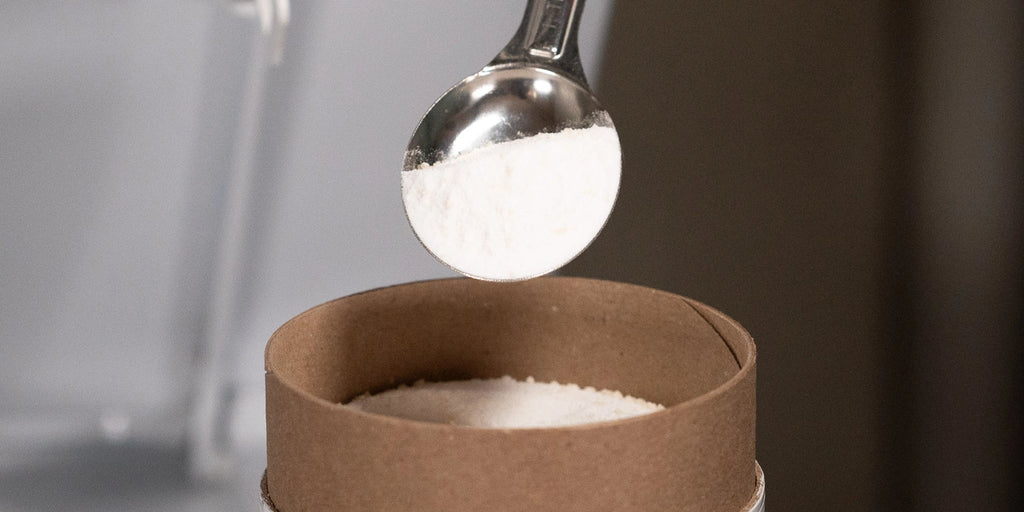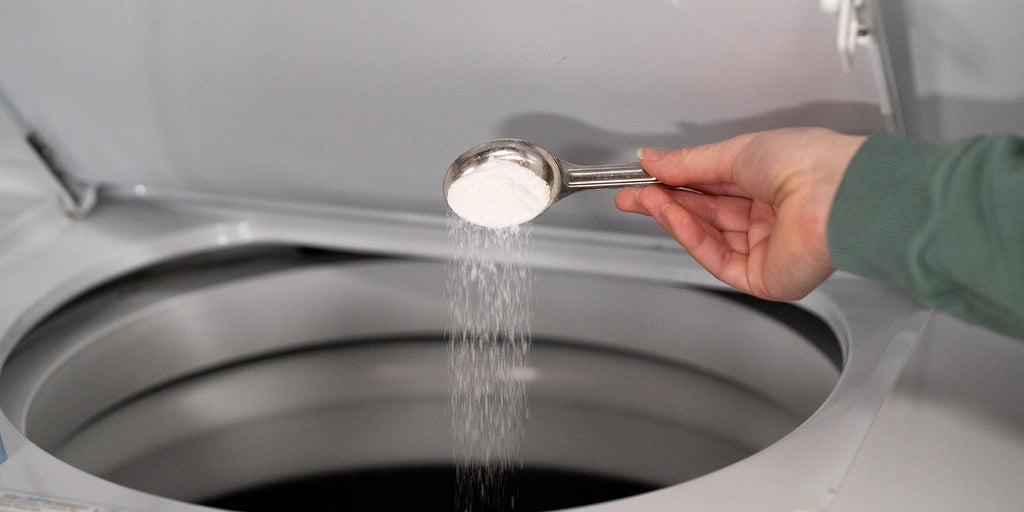Bleach has long been considered a household staple for laundry, cleaning, and disinfecting. While bleach is certainly versatile, it’s also a strong irritant that’s toxic for people and the planet and extremely dangerous when mixed with other chemicals. You and your home deserve better. That’s why we put together this guide of how-tos and FAQs to help you use our Oxygen Brightener bleach alternative.
How to use Oxygen Brightener safely
Oxygen Brightener is a safer alternative to chlorine bleach. Its cleaning power comes from sodium percarbonate, an oxidizing agent that breaks down organic compounds. It’s a more people and planet-friendly bleach alternative that cleans, whitens, deodorizes, and removes stains from fabrics and surfaces.
While sodium percarbonate is safer for your family and the environment than chlorine bleach, it is still a powerful chemical that should be used properly. However you use Oxygen Brightener, be sure to follow these safety guidelines:
- Do not mix Oxygen Brightener with other chemicals such as chlorine or ammonia. While sodium percarbonate is generally not as dangerous as bleach or ammonia, it’s always safest to avoid mixing chemicals and products that are not designed to work together. Oxygen Brightener is safe to use with our other products, like Laundry Powder and Soap Stick — in fact, we recommend it!
- Do not store Oxygen Brightener and water solutions in sealed containers. The reaction between sodium percarbonate and water releases gas, which creates pressure in sealed containers.
- We do not recommend using Oxygen Brightener with septic systems. While your system may be able to handle a small amount of Oxygen Brightener, we recommend consulting a septic system professional before use. Oxygen Brightener is gentler on septic systems than chlorine bleach, sodium percarbonate is an oxidizing agent that kills the bacteria that are necessary for septic systems to work properly.
- Avoid contact with eyes and skin and do not ingest. In case of eye contact, rinse your eyes with water for 15 minutes. In case of skin contact, wash the affected area with soap and water. If ingested, drink plenty of water to dilute, and do not induce vomiting.
How to use Oxygen Brightener as a laundry booster
Oxygen Brightener is an easy and effective laundry booster. The combination of sodium percarbonate and washing soda softens hard water, helps detergents penetrate deeper into fabrics, and breaks down organic compounds.
For best results, follow these steps:
- Only use Oxygen Brightener as directed on compatible fabrics
- Use Oxygen Brightener with Laundry Powder
- Use the right amount of powder for your machine and load
- Place powder directly in the washing machine drum before adding clothes
- Use the right temperature setting for your machine and season
We’ll walk through each of these steps in more detail.
Only use Oxygen Brightener as directed on compatible fabrics
Oxygen Brightener is safe for many fabrics, including lights, darks, colors, cotton, synthetics, and more. It is a color-safe bleach alternative that’s effective at brightening clothes and removing stains. However, it should not be used to clean wool, silk, and other fabrics made from delicate natural fibers.
Here is a complete list of fabrics you can clean with our products. Be sure to follow the safety guidelines at the beginning of this guide when using Oxygen Brightener to do laundry.
Use Oxygen Brightener with Laundry Powder
Oxygen Brightener is designed to enhance the performance of laundry detergents like our Laundry Powder. Use it to soften hard water, break down tough stains, remove odors like sweat and smoke, and brighten faded whites. It’s especially useful for fabrics where dirt and odors build up over time, like workout clothes, bath towels, and rags.
How much Oxygen Brightener to use per load
How much Oxygen Brightener you should use depends on your washing machine and the size and soil level of the load you’re washing. Start with 1 tablespoon in both high-efficiency (HE) and standard (non-HE) washers. The stainless steel scoop that comes with our Laundry Powder canister measures 1 tablespoon, making it easy to scoop what you need.
 You can adjust the amount of powder used based on the size of the load. For very small loads, use a bit less. For very large loads, add a bit more. The goal is to get enough powder to effectively clean your clothes while completely dissolving in the wash.
You can adjust the amount of powder used based on the size of the load. For very small loads, use a bit less. For very large loads, add a bit more. The goal is to get enough powder to effectively clean your clothes while completely dissolving in the wash.
The same goes for the soil level of the load. If your clothes are very dirty or stained, such as from gardening, exercising, or cooking, you can add a bit more powder. If they just need a light clean, you can use less powder.
Where to put Oxygen Brightener in the washing machine
In both front-loading and top-loading washing machines, add the powder directly to the drum before adding clothes. This prevents powder from getting caught in your clothes during the wash and ensures that water can easily reach and dissolve the powder.
For best results, do not add the powder to the dispenser drawer. Machines that are designed for liquid detergents and boosters may not flush the drawer with enough water to dissolve and wash out powders. Undissolved powder can build up in your machine and cause unwanted odors and dinginess.

What temperature water to use for laundry with Oxygen Brightener
Oxygen Brightener is designed to work in the same water temperatures as laundry detergent. In modern washing machines, the ‘cold’ setting mixes hot and cold water to reach 60 degrees F, the minimum temperature required for laundry detergents. That means in most cases you can use the cold cycle to save energy and money while washing your clothes.
However, there are some exceptions:
Cold weather laundry
‘Tap cold’ uses water straight from the pipes in your home without adjusting the temperature. For best results, we recommend using ‘cold’ instead of ‘tap cold’ if your machine has both options.
During the cold winter months, the ‘tap cold’ water temperature can dip below 60 degrees. When doing laundry in freezing weather, you might want to use ‘semi-warm’ or ‘warm’ to ensure that the water gets to the right temperature fast enough.
Sanitizing
Cold water works great for regular washing, but hot water is recommended for sanitizing. According to the CDC, “you probably do not need to sanitize or disinfect unless someone in your home is sick or someone sick has recently visited.” Since hot water uses more energy and can be hard on your clothes, we recommend saving it for when someone is sick.
Care instructions
Certain fabrics may require specific water temperatures. While cold water is best for delicate, dark, and colorful fabrics, some items may benefit from warmer water temperatures. For best results, always defer to the care instructions on the product tag.
Our Oxygen Brightener is color-safe, so you can use it on lights, darks, and colors. It is not safe for delicate natural fibers, including wool and silk.
How to use Oxygen Brightener as an oxygen cleaner
Oxygen Brightener is a powerful stain remover, deodorizer, and general-purpose cleaner with many uses around the house. It excels at removing organic matter like dirt, sweat, oil, grease, and coffee. For best results, follow these steps:
- Only use Oxygen Brightener as directed on compatible surfaces
- Create a liquid solution by mixing Oxygen Brightener with warm water
- Use the solution to clean surfaces and soak objects
- Wash and rinse surfaces and objects thoroughly after cleaning
We’ll walk through each of these steps in more detail.
Only use Oxygen Brightener as directed on compatible surfaces
Oxygen Brightener is a versatile cleaner that can be used to clean dishes, mugs, thermoses, cookware, trash cans, tubs, tiles, grout, and more. It should not be used on delicate or natural materials, such as jewelry, wood, or painted surfaces.
Here is a complete list of surfaces you can clean with our products. Be sure to follow the safety guidelines at the beginning of this guide when using Oxygen Brightener around the house.
Create a liquid solution of Oxygen Brightener and water
How much Oxygen Brightener and water you mix together depends on what you want to clean and how strong of a cleaner you want to make. Start with 1 tablespoon of powder for each 16 ounces of warm water. For a bigger batch, that’s about 1/2 cup of powder for each gallon of water.

This makes a liquid solution that’s effective for general cleaning. For very soiled items or extra tough stains, you can make a stronger solution by adding more powder. You can even make a heavy-duty cleaning paste by mixing equal parts of Oxygen Brightener and water, such as 1 tablespoon of each. This is a great solution for cleaning grout.
Mix only as much solution as you need for the task at hand. The ingredients in Oxygen Brightener react with the water and lose effectiveness over time, so it’s better to make a new solution each time you need one.
Be careful not to mix or store the mixed solution in sealed containers. The reaction between sodium percarbonate and water releases gas, which can create pressure when trapped in a sealed container. If you’re using the solution to soak a water bottle, thermos, or other resealable container, keep the lid off while soaking.
Use the solution to clean surfaces and soak objects
Use the liquid solution with a rag, sponge, or scrub brush to clean a variety of surfaces. This method is great for scrubbing away mold from showers and tubs, removing food stains from sinks and countertops, and deodorizing trash cans.

Oxygen Brightener is fantastic for soaking a wide range of different items. Prepare a solution of the desired strength in a bucket or similar open container, then submerge whatever you want to clean for up to 6 hours.
Here are some of our favorite things to soak:
- Strip coffee and tea stains from mugs, thermoses, kettles, and carafes
- Remove set-in oil and grease from stainless steel pots and pans
- Get rid of residue from hard-to-remove stickers and labels
- Deodorize smelly workout clothes and sports gear like helmets and shin guards
- Remove smoky odors from clothes that spent too much time near a bonfire
- Brighten dingy whites by pre-soaking them before the wash cycle

Rinse surfaces and objects thoroughly after cleaning
Be sure to rinse surfaces and objects with water after soaking and cleaning them with Oxygen Brightener. This will prevent the Oxygen Brightener from drying and sticking to the items. It also prevents anyone from handing them from getting irritated skin or eyes from direct contact with sodium percarbonate.
To rinse objects that you soaked or scrubbed, simply hold them under running water from the faucet. Use a sponge, dish cloth, or scrub brush to wipe any hard-to-reach crevices and loosen any remaining powder or dirt.
Rinse hard surfaces with warm water by spraying them with a spray bottle or wringing out a wet cloth or towel. Use a clean, dry cloth or towel to wipe everything up until completely dry for a streak-free finish.
Use Oxygen Brightener with Soap Stick for clothing stains
For extra tough or set-in stains, add an Oxygen Brightener soak to your stain removal process. Follow these steps:
- Use the Soap Stick as directed
- Create an Oxygen Brightener solution as directed above
- Soak the stained fabric in the solution between 30 minutes and 6 hours, depending on the stain and how long it has been sitting
- Wash as normal
- Check stain before drying and repeat steps 1–4 if necessary
Do not use Oxygen Brightener on wool or silk, or if you have a septic tank.
How to open the Oxygen Brightener container
Our plastic-free Oxygen Brightener is packaged in a paper canister with steel ends. To open it, follow these steps:
- Cut the adhesive tab that connects the lid to the can
- Loosen the lid slightly
- Remove the lid from the can using a twisting motion
- Wipe the lid and the top of the can to remove any loose powder
Let’s break that down:
- Start by gently cutting the adhesive tab that holds the lid in place using a table knife.

- Holding the can by the bottom end, you can then loosen the lid slightly by running a table knife along the edge between the lid and the can. Don’t press too hard during this step, as there is nothing to cut other than the adhesive tab and you don’t want to damage the canister.

- Firmly grasp the can in one hand and the lid in another. Use a gentle unscrewing motion to loosen the lid while slowly twisting it upward.

- Once you’ve removed the lid, check for any loose powder where the lid connects to the top of the canister. Wiping this area with a dry cloth can help reduce friction caused by powder caught between the can and the lid.

How to store Oxygen Brightener
Oxygen Brightener can be stored in the paper-and-steel it comes in or in the container of your choice. It does not expire. However, if exposed to moisture or humidity, the powder can harden and clump up. This does not reduce its effectiveness, but it should be broken up or crumbled back into a powder before use. If you plan to store oxygen powder in a humid environment, we recommend using an airtight container, such as a hinged jar with a rubber gasket. For heavy cleaners and launderers, our zero-waste Oxygen Brightener bucket is a great bulk option that includes a resealable lid.
Whatever container you choose, you can save money and reduce waste with our Oxygen Brightener refills. Each refill contains the same amount of powder as the canister, but comes in recyclable all-paper packaging.

